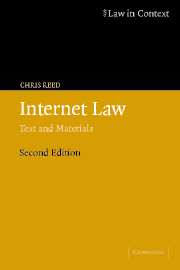Book contents
- Frontmatter
- Contents
- Preface
- Table of UK Statues
- Table of statutes–foreign jurisdictions
- Table of European Communities legislation
- Table of Conventions and Agreements
- Table of cases
- Introduction
- 1 The Internet as a distributed environment
- 2 From each according to his ability : actors and activities in the Internet world
- 3 An infinity of scarce resources : ownership and use of Internet resources
- 4 New actors on a new stage : intermediary liability in the Internet world
- 5 On the Internet, nobody knows you're a dog: identity and identification
- 6 Old wine in new bottles : traditional transactions in the Internet environment
- 7 The long arm of the law : cross-border law and jurisdiction
- 8 Legislative and regulatory arbitrage
- 9 Enforceability in the Internet environment
- 10 Facing the legislative and regulatory challenge
- Index
Introduction
Published online by Cambridge University Press: 05 June 2012
- Frontmatter
- Contents
- Preface
- Table of UK Statues
- Table of statutes–foreign jurisdictions
- Table of European Communities legislation
- Table of Conventions and Agreements
- Table of cases
- Introduction
- 1 The Internet as a distributed environment
- 2 From each according to his ability : actors and activities in the Internet world
- 3 An infinity of scarce resources : ownership and use of Internet resources
- 4 New actors on a new stage : intermediary liability in the Internet world
- 5 On the Internet, nobody knows you're a dog: identity and identification
- 6 Old wine in new bottles : traditional transactions in the Internet environment
- 7 The long arm of the law : cross-border law and jurisdiction
- 8 Legislative and regulatory arbitrage
- 9 Enforceability in the Internet environment
- 10 Facing the legislative and regulatory challenge
- Index
Summary
Aims and methodology
The most difficult task when writing a legal text is deciding what to leave out. This difficulty is compounded at least a hundred-fold when the subject of the book is Internet law. The reason for this becomes apparent when the so-called ‘Cyberspace fallacy’ is examined more closely.
The Cyberspace fallacy states that the Internet is a new jurisdiction, in which none of the existing rules and regulations apply. This jurisdiction has no physical existence; it is a virtual space which expands and contracts as the different networks and computers, which collectively make up the Internet, connect to and disconnect from each other. The geographical locations where activities occur are often purely fortuitous, dictated by the then current configuration of the Internet. The world-wide accessibility of the Internet means that no one legal jurisdiction has de jure or de facto control of these activities. From all this, it is concluded that no jurisdiction has any control.
A moment's thought reveals the fallacy. All the actors involved in an Internet transaction have a real-world existence, and are located in one or more legal jurisdictions. The computing and communications equipment through which the transaction takes place is also located in legal jurisdictions, even though it may be difficult to identify precisely which equipment was in fact used. It is inconceivable that a real-world jurisdiction would deny that its laws potentially applied to the transaction.
- Type
- Chapter
- Information
- Internet LawText and Materials, pp. 1 - 6Publisher: Cambridge University PressPrint publication year: 2004
- 1
- Cited by

